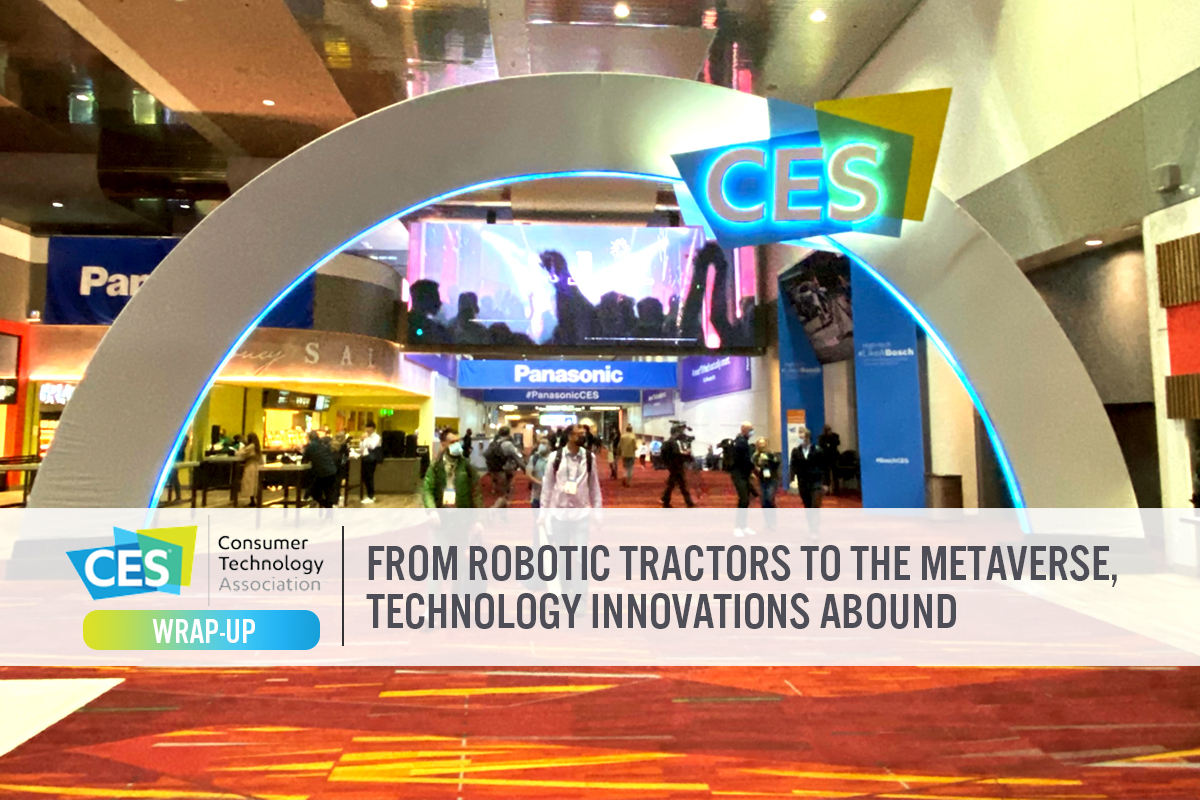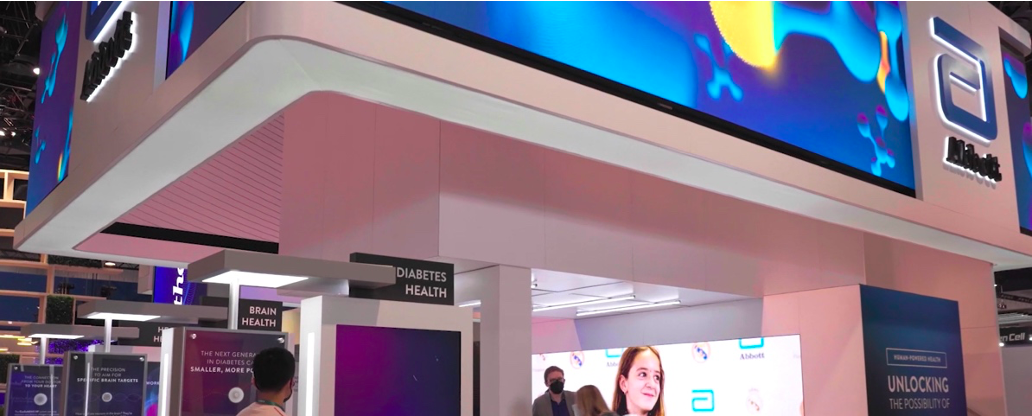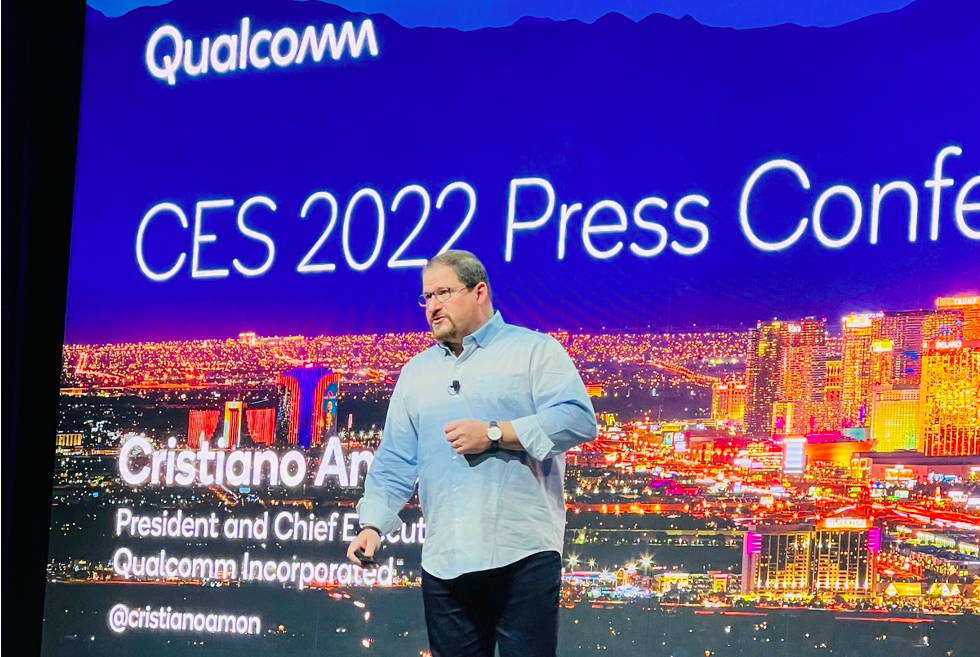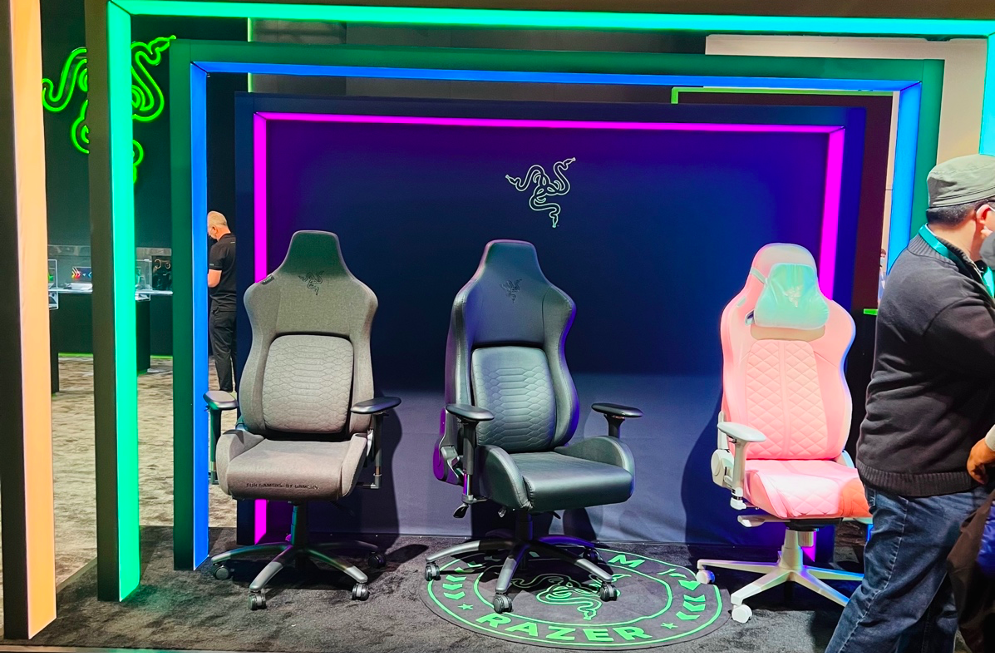
Nitheesh NH
The Coresight Research team attended this year’s CES (formerly the Consumer Electronics Show), hosted by the Consumer Technology Association (CTA) in Las Vegas, US. Two media days took place on January 3–4, 2022, followed by the exhibition and conference on January 5–7.
Attendance was around 40,000, according to the CTA—about one-third of pre-pandemic levels. Although many large technology companies pulled out of attending, there was still a full slate of sessions, exhibits and product showcases.
In this report, we present our top 10 insights from the full five-day event.
[caption id="attachment_139268" align="aligncenter" width="700"] Deborah Weinswig, CEO and Founder of Coresight Research, and Richard Marooney, Analyst at Coresight Research, attend CES 2022
Deborah Weinswig, CEO and Founder of Coresight Research, and Richard Marooney, Analyst at Coresight Research, attend CES 2022
Source: Coresight Research[/caption] Connected, electronic mobility was a key theme at CES 2022
Connected, electronic mobility was a key theme at CES 2022
Source: Coresight Research[/caption] 4. Abbott Laboratories Joins the Consumer-Electronics Core with Biosensing Wearables Wearable and health technologies have gained traction at CES in recent years, but 2022 marked the first keynote speech delivered by a US medical device manufacturer, Abbot Laboratories. The company has been offering continuous glucose-monitoring products for diabetics since 2014. At CES, Abbott unveiled its new line of consumer bio-wearables for general health and wellness applications, known as Lingo. The device will initially track key signals in the body— including glucose, ketones and lactate—and the tracking of alcohol levels could be added in the future. Tracking glucose levels helps people manage their weight, sleep, energy and mental clarity, and tracking ketones is relevant for diet and weight loss. Abbott is set to release the first Lingo wearable (to track ketones) in Europe later in 2022. [caption id="attachment_139272" align="aligncenter" width="700"] Medical device and wearable technology manufacturer Abbott Laboratories at CES 2022
Medical device and wearable technology manufacturer Abbott Laboratories at CES 2022
Source: Company website[/caption] 5. Differing Views of 5G Wireless: Fiber or Industrial? 5G networks have been deployed in the US, and 5G handsets are available from major vendors such as Apple and Samsung, yet the “killer app” that makes these networks valuable remains under development. Steve Koenig, VP of Research at the CTA, believes that its adoption as part of the industrial Internet of Things would be a major driver of 5G adoption, supported by remote work and growing cloud infrastructure. Cristiano Amon, President and CEO of tech company Qualcomm, offered a controversial view, claiming that the high data rates of 5G wireless would supplant traditional wireline networks (such as fiber to the home or cable modems), bringing broadband to everyone. Fixed wireless technologies could be deployed rapidly without the need to dig trenches or lay cables on telephone poles. 6. Automobiles Are Becoming Customized and Personalized Amon presented on Qualcomm’s activity in the automotive space, which leverages the company’s Snapdragon processors and extends well beyond its leadership of the smartphone category. Automobiles are being transformed with telematics (hosting an array of cameras and other sensors), connectivity and advanced infotainment systems, whose functionality can be customized like setting the wallpaper on a smartphone display. Qualcomm is expanding its leadership to automotive electronics, with more than 25 global automakers having selected Snapdragon to control their cockpit platforms, including GM and BMW. One example of the level of customization is that Qualcomm’s chips offer functionality to control ceiling displays within automobiles. [caption id="attachment_139273" align="aligncenter" width="700"] Cristiano Amon, President and CEO of Qualcomm
Cristiano Amon, President and CEO of Qualcomm
Source: Coresight Research[/caption] 7. The Building Blocks of the Metaverse Are a Hot Topic The metaverse was a key topic at this year’s CES—unsurprising given that prior iterations of the event had already added many of the building blocks to this technology, such as AR/VR (augmented/virtual reality) headsets and gaming hardware. The metaverse conference merged with digital media coverage, and the conference rooms at the Aria hotel were devoted to the topic. Even nontraditional metaverse companies joined the fray: Hyundai enabled attendees to create their own avatar to test drive a virtual car, and Samsung is reportedly opening a virtual version of its New York City flagship in the Decentraland VR platform. There are many other building blocks to the metaverse, including cryptocurrencies, blockchain, smart contracts and non-fungible tokens (NFTs), which manage ownership of digital properties. 8. Agriculture and Food Service Employ Automation To Counter Labor Shortages Agricultural equipment manufacturer John Deere made a big slash at CES with a press conference and its announcement of new autonomous farm equipment—and other agricultural robotics companies also had their solutions on display. While tractors are not a typical consumer electronics product, autonomous versions rely on the same AI (artificial intelligence) and automation technology as other electric and autonomous vehicles. They free farmers from the task of driving their vehicles and provide data that can be analyzed to inform business decisions. This is particularly important amid labor shortages, with workers continuing to move from rural to urban areas. [caption id="attachment_139274" align="aligncenter" width="700"] An autonomous weeding and agricultural robot from Naio Technologies
An autonomous weeding and agricultural robot from Naio Technologies
Source: Coresight Research[/caption] Labor shortages are dramatically affecting the restaurant industry as well, and food technology was a new area of focus at CES 2022. We visited a working, automated pizza station on the show floor, powered by an innovator called Picnic. The equipment is able to produce pizzas with a variety of toppings on a conveyor belt for transfer into an automatic oven, and the line is able to produce salads and other food items as well. 9. Technology Is Evolving To Offer New Ways of Enhancing Sustainability Samsung discussed its sustainability efforts—covering solar power, sustainable packaging and e-waste—in the first half of its keynote address at CES. Home appliances are becoming more connected; they are now able to share information, such as reporting energy usage versus the thermostat setting. Intelligent vehicles can also communicate with other devices, telling the home automation system to turn on the lights when the owner pulls into the driveway, for example. The electrification of vehicles, as evidenced by GM’s plan to offer 30 electric vehicles by 2025, means fewer carbon emissions from transportation and delivery. FedEx and Walmart have set goals for the deployment of electrical delivery vehicles. Future vehicles are also more likely to access citywide communication networks, which can eliminate congestion and congestion-related pollution. 10. Computer Gaming and Technology Power Innovation, the Metaverse, and Health and Wellness Gaming has long been a driver of PC performance due to its heavy need for processing and graphics power, and Intel focused on gaming in its introduction of 12th generation processors. Graphics and processing power will also be a major building block of the metaverse experience. Many consumers turned to gaming for entertainment or to relieve stress while sheltering at home amid the pandemic, which has only increased their reliance on, and comfort in participating in, the gaming world. Gaming techniques and metaphors are thus a familiar medium for collecting health and wellness data and treating a wide variety of conditions, including anxiety, diabetes, sleep disorders and substance abuse—and in some cases replacing medicines entirely. Moreover, gaming platforms can create communities that disseminate health tips and information to underserved populations. [caption id="attachment_139275" align="aligncenter" width="700"] Gaming technology companies such as Razer exhibited at CES 2022
Gaming technology companies such as Razer exhibited at CES 2022
Source: Coresight Research[/caption]
 Deborah Weinswig, CEO and Founder of Coresight Research, and Richard Marooney, Analyst at Coresight Research, attend CES 2022
Deborah Weinswig, CEO and Founder of Coresight Research, and Richard Marooney, Analyst at Coresight Research, attend CES 2022Source: Coresight Research[/caption]
CES 2022 Wrap-Up: Coresight Research Insights
1. CES Continues To Add New Verticals Every Year The event broadens its focus every year. Autonomous and electric vehicles and new media were added a couple of years ago, and healthcare continues to permeate the consumer sector, including wearables, sleep technology and other gadgets. Mental health has been another common topic and source for innovation in recent years, particularly in 2021 owing to pandemic-related stresses. This year, CES expanded upon those themes and added several new ones: food tech, space tech and digital assets. New media and digital assets occupied an entire venue—the Aria hotel. The US space program generated an enormous number of spin-off technologies that are the basis for products we use every day. 2. Technology Platforms Launch Multiple Related Products CES continued to see the emergence of cooperation and collaborations this year, with companies working together to develop solutions that require a broad suite of hardware, software and applications that are too extensive for a single company to undertake. The product showcases in particular—CES Unveiled, Pepcom and Showstoppers—saw many companies exhibit new technology platforms that enable the launch of a suite of related products. For example, Baracoda Daily Healthtech demonstrated a line of connected digital thermometers with manual charging, as well as a connected bath mat that tracks and shares data on the user’s weight, body-fat measurements and other metrics.- Read our separate reports on 10 technology innovations from the Pepcom and Showstoppers exhibits.
 Connected, electronic mobility was a key theme at CES 2022
Connected, electronic mobility was a key theme at CES 2022Source: Coresight Research[/caption] 4. Abbott Laboratories Joins the Consumer-Electronics Core with Biosensing Wearables Wearable and health technologies have gained traction at CES in recent years, but 2022 marked the first keynote speech delivered by a US medical device manufacturer, Abbot Laboratories. The company has been offering continuous glucose-monitoring products for diabetics since 2014. At CES, Abbott unveiled its new line of consumer bio-wearables for general health and wellness applications, known as Lingo. The device will initially track key signals in the body— including glucose, ketones and lactate—and the tracking of alcohol levels could be added in the future. Tracking glucose levels helps people manage their weight, sleep, energy and mental clarity, and tracking ketones is relevant for diet and weight loss. Abbott is set to release the first Lingo wearable (to track ketones) in Europe later in 2022. [caption id="attachment_139272" align="aligncenter" width="700"]
 Medical device and wearable technology manufacturer Abbott Laboratories at CES 2022
Medical device and wearable technology manufacturer Abbott Laboratories at CES 2022Source: Company website[/caption] 5. Differing Views of 5G Wireless: Fiber or Industrial? 5G networks have been deployed in the US, and 5G handsets are available from major vendors such as Apple and Samsung, yet the “killer app” that makes these networks valuable remains under development. Steve Koenig, VP of Research at the CTA, believes that its adoption as part of the industrial Internet of Things would be a major driver of 5G adoption, supported by remote work and growing cloud infrastructure. Cristiano Amon, President and CEO of tech company Qualcomm, offered a controversial view, claiming that the high data rates of 5G wireless would supplant traditional wireline networks (such as fiber to the home or cable modems), bringing broadband to everyone. Fixed wireless technologies could be deployed rapidly without the need to dig trenches or lay cables on telephone poles. 6. Automobiles Are Becoming Customized and Personalized Amon presented on Qualcomm’s activity in the automotive space, which leverages the company’s Snapdragon processors and extends well beyond its leadership of the smartphone category. Automobiles are being transformed with telematics (hosting an array of cameras and other sensors), connectivity and advanced infotainment systems, whose functionality can be customized like setting the wallpaper on a smartphone display. Qualcomm is expanding its leadership to automotive electronics, with more than 25 global automakers having selected Snapdragon to control their cockpit platforms, including GM and BMW. One example of the level of customization is that Qualcomm’s chips offer functionality to control ceiling displays within automobiles. [caption id="attachment_139273" align="aligncenter" width="700"]
 Cristiano Amon, President and CEO of Qualcomm
Cristiano Amon, President and CEO of QualcommSource: Coresight Research[/caption] 7. The Building Blocks of the Metaverse Are a Hot Topic The metaverse was a key topic at this year’s CES—unsurprising given that prior iterations of the event had already added many of the building blocks to this technology, such as AR/VR (augmented/virtual reality) headsets and gaming hardware. The metaverse conference merged with digital media coverage, and the conference rooms at the Aria hotel were devoted to the topic. Even nontraditional metaverse companies joined the fray: Hyundai enabled attendees to create their own avatar to test drive a virtual car, and Samsung is reportedly opening a virtual version of its New York City flagship in the Decentraland VR platform. There are many other building blocks to the metaverse, including cryptocurrencies, blockchain, smart contracts and non-fungible tokens (NFTs), which manage ownership of digital properties. 8. Agriculture and Food Service Employ Automation To Counter Labor Shortages Agricultural equipment manufacturer John Deere made a big slash at CES with a press conference and its announcement of new autonomous farm equipment—and other agricultural robotics companies also had their solutions on display. While tractors are not a typical consumer electronics product, autonomous versions rely on the same AI (artificial intelligence) and automation technology as other electric and autonomous vehicles. They free farmers from the task of driving their vehicles and provide data that can be analyzed to inform business decisions. This is particularly important amid labor shortages, with workers continuing to move from rural to urban areas. [caption id="attachment_139274" align="aligncenter" width="700"]
 An autonomous weeding and agricultural robot from Naio Technologies
An autonomous weeding and agricultural robot from Naio TechnologiesSource: Coresight Research[/caption] Labor shortages are dramatically affecting the restaurant industry as well, and food technology was a new area of focus at CES 2022. We visited a working, automated pizza station on the show floor, powered by an innovator called Picnic. The equipment is able to produce pizzas with a variety of toppings on a conveyor belt for transfer into an automatic oven, and the line is able to produce salads and other food items as well. 9. Technology Is Evolving To Offer New Ways of Enhancing Sustainability Samsung discussed its sustainability efforts—covering solar power, sustainable packaging and e-waste—in the first half of its keynote address at CES. Home appliances are becoming more connected; they are now able to share information, such as reporting energy usage versus the thermostat setting. Intelligent vehicles can also communicate with other devices, telling the home automation system to turn on the lights when the owner pulls into the driveway, for example. The electrification of vehicles, as evidenced by GM’s plan to offer 30 electric vehicles by 2025, means fewer carbon emissions from transportation and delivery. FedEx and Walmart have set goals for the deployment of electrical delivery vehicles. Future vehicles are also more likely to access citywide communication networks, which can eliminate congestion and congestion-related pollution. 10. Computer Gaming and Technology Power Innovation, the Metaverse, and Health and Wellness Gaming has long been a driver of PC performance due to its heavy need for processing and graphics power, and Intel focused on gaming in its introduction of 12th generation processors. Graphics and processing power will also be a major building block of the metaverse experience. Many consumers turned to gaming for entertainment or to relieve stress while sheltering at home amid the pandemic, which has only increased their reliance on, and comfort in participating in, the gaming world. Gaming techniques and metaphors are thus a familiar medium for collecting health and wellness data and treating a wide variety of conditions, including anxiety, diabetes, sleep disorders and substance abuse—and in some cases replacing medicines entirely. Moreover, gaming platforms can create communities that disseminate health tips and information to underserved populations. [caption id="attachment_139275" align="aligncenter" width="700"]
 Gaming technology companies such as Razer exhibited at CES 2022
Gaming technology companies such as Razer exhibited at CES 2022Source: Coresight Research[/caption]